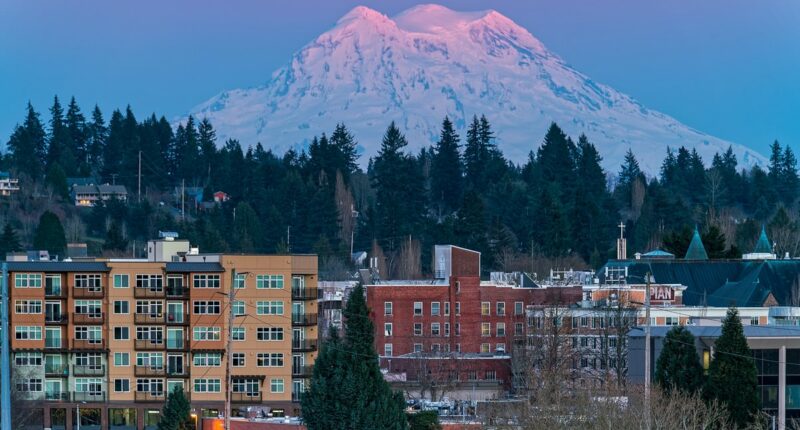Share this @internewscast.com
Mount Rainier in Washington has recently stirred with continuous seismic activity, sparking concerns about a possible eruption in the near future.
This iconic peak is considered one of the most hazardous volcanoes in the United States, looming over densely populated areas including Seattle, Tacoma, and Yakima in Washington, as well as Portland in Oregon.
Since Saturday, Mount Rainier has been experiencing a persistent series of small tremors, creating a nearly unbroken sequence of vibrations beneath the surface.
The Pacific Northwest Seismic Network (PNSN) has detected these ongoing seismic signals. Their seismometers have recorded three consecutive days of intense, continuous seismic activity across the volcano’s western flank.
Unlike the sharp jolts associated with significant earthquakes, the current seismic pattern resembles that of a volcanic tremor—a steady hum caused by the movement of magma, hot water, and gases within the volcano.
While this doesn’t indicate an immediate eruption, it serves as a potential warning sign that volcanic activity could escalate to more dangerous levels.
Geologists will be watching for key signs of this volcanic tremor escalating, including its severity increasing in the coming days, actual earthquakes starting inside the volcano, and the ground at Mount Rainier beginning to swell.
When this volcano eventually explodes, it won’t be scorching lava flows or choking clouds of ash that threaten Americans, but the lahars: violent, fast-moving mudflows that can tear across entire communities in mere minutes.

Mount Rainier, one of the most dangerous volcanos in the US, looms over Olympia, Washington. This city is home to more than 50,000 people

The activity at Mount Rainier started with a sharp spike around 5am ET on November 15. After that, the line gets fuzzier and fuzzier, showing vibrations that never calm down
Large lahars can crush, bury, or carry away almost anything in their paths, according to the US Geological Survey.
Volcano watchers on social media spotted the fresh readings from PNSN, noting that vibrations under the mountain went from normal to chaotic in a matter of hours.
Seismometers registered a sharp spike around 5am ET on Saturday, which proceeded to grow in strength throughout the day.
On seismic instruments, this was recorded as a line that continued to get fuzzier and fuzzier as more time passed, eventually looking like a thick black line as the vibrations increased.
By November 16, almost the entire 24 hours lit up seismometers with a solid thick black band with very little quiet time.
On Monday, the readings at Mount Rainier showed an almost solid black line, revealing overlapping vibrations for 80 to 90 percent of the day.
None of the next warning signs for an eruption have emerged on Tuesday, so the threat level has not been raised by USGS.
However, this volcanic tremor has been one of the longest episodes at Rainier in recent years, and USGS continues to list the overall risk of a future eruption as ‘Very High.’

The volcanic tremor continued into November 16, with seismometers recording almost no quiet moments throughout the entire day

On Monday, the readings from Pacific Northwest Seismic Network recorded an almost solid map of activity on Mount Rainier’s western slope
Mount Rainier has already experienced massive swarms of earthquakes earlier this year, sparking fears of an imminent volcanic explosion.
In July, over 1,000 earthquakes rocked the area over a span of more than three weeks, in the largest ever seismic swarm recorded at the mountain.
That swarm easily surpassed the last large string of earthquakes at Mount Rainier, which came in 2009, lasting only three days and producing around 120 minor earthquakes.
The swarm in July started during the morning of July 8 saw up to 41 minor earthquakes registering every hour throughout the rest of the month.
The 1980 eruption of Mount Saint Helens, located just 50 miles from Mount Rainier, may have provided a concerning preview of what the Pacific Northwest can expect from Rainier’s expected future eruption.
That volcanic event also produced a dangerous lahar that destroyed more than 200 homes, over 185 miles of roads, and contributed to the total death toll of 57 people.
These tragic events have helped scientists better understand the threat that lahars pose to human communities around active volcanoes, and experts are currently preparing for the terrifying possibility of a lahar forming at Mount Rainier.






